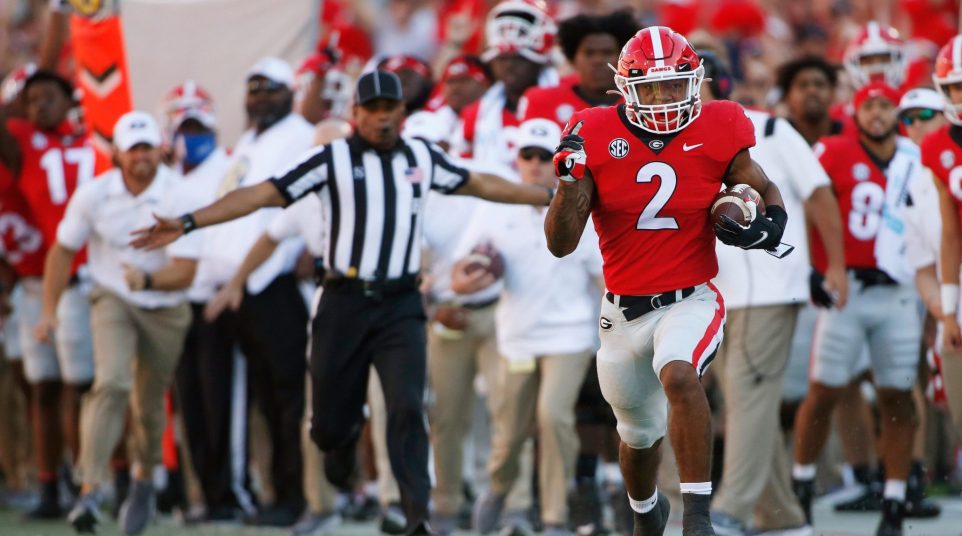
Georgia football: Yes, the defense is dominant, but Todd Monken deserves credit, too
So much has been made about the dominant Dawgs on defense, and the hand-wringing over the quarterback decisions and health that Todd Monken’s offense has been somewhat overlooked.
If not for the QB battle, and Jordan Davis swallowing blockers and running backs like it’s discount night at the Last Resort Grill, the story has been Monken, who has taken the slew of new faces at receiver and found ways to combine them with the big-play tight ends and versatile running backs to carve up defenses.
Georgia, for all the changing faces and machinations on offense, reaches the bye week No. 4 in the SEC in scoring offense, and No. 4 in 3rd-down conversions.
How does the boss think offensive coordinator Monken has done so far?
“I think he’s done an incredible job when you think about the guys he’s had in,” coach Kirby Smart said. “He’s taken tight ends and made them multiple. He’s taken backs. He’s taken wideouts that weren’t necessarily early-season starters and done a really good job. When you think about it, he’s called the game with players, not plays. When you dial up 19 (Brock Bowers) and 84 (Ladd McConkey) and 4 (James Cook) and 3 (Zamir White) and 5 (Adonai Mitchell), he does a good job of keeping defenses off balance.”
In the 30-13 victory, Georgia handed Kentucky its first loss and it wasn’t all about the smothering defense. The offense, in fact, became the highest-scoring opponent against Kentucky this season, and also collected the most yards (416 to 408), and had an eye-popping 8.9 yards per play (previous high was 5.9).
Remember, the injured or unavailable list includes the likes of Jermaine Burton, Arian Smith, George Pickens, Dominick Blaylock and Arik Gilbert. Oh, and JT Daniels.
UGA’s dominance on D has everyone overlooking the success they’ve had on O as of late.
Todd Monken calling a lot of downfield play-action passes out of heavy personnel & Stetson Bennett is hitting.
Bennett on 10+ yd PA throws: 16/21, 506 yds, 5 TD ⬇️ pic.twitter.com/JtS0uLTVdq
— Anthony Treash (@PFF_Anthony) October 18, 2021
Besides scheming up the players in the right situations, Monken has helped Georgia create the big-play threat, and the Bulldogs are No. 5 in the SEC in plays of 20-plus yards, and also No. 5 in the SEC of plays of at least 50 yards.
Against Kentucky, there was Kendall Milton’s 35-yard run (Georgia’s longest run of the season), Zamir White’s 24-yard touchdown and James Cook’s 25-yard run. Both of Brock Bowers’ touchdowns went for at least 20 yards, and a would-be 59-yard play was called back by a penalty. And John FitzPatrick chipped in a 20-yard catch. Those types of plays help Georgia absorb the trouble of going 2-for-7 on 3rd down. Overall, Georgia had 9 plays of more than 20 yards.
“We want to be an explosive football team, we feel like at full strength with our wideouts we can be really explosive,” Smart said. “Coming into the year, we felt that was one of the strengths of our team. It’s been an injured portion of our team. We have quarterbacks to get them the ball, we have an offensive line that can protect. We have good backs. We just have to keep building and getting better and playing cleaner football. I felt (Saturday) was one of the least clean offensive football games in terms of not giving up negative plays and those kind of things. Just hurting drives. But we accompanied that with explosive plays.”
Mark Stoops lamented that Georgia’s backs put such pressure on a defense with a big-play threat that, “if you’re not precise, they’re going to make you pay.”
Stoops recalled one play on Saturday where 2 defenders hit the hole together, almost too fast in fact, and instead of a 2-yard gain, it’s a 20- or 30-yard gain.
What Monken has developed is if there’s a crease, Georgia playmakers will take it and never look back.
